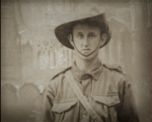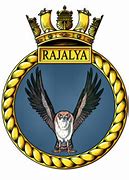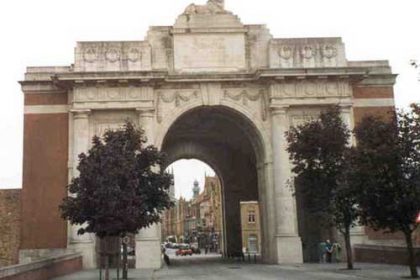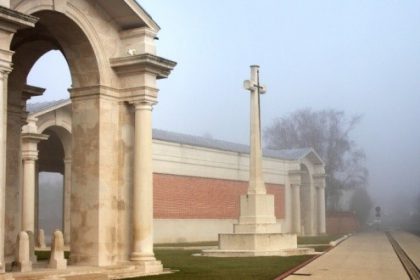Towards the latter end of the first world war, a ship left the port of Liverpool bound for Canada. Along with the crew of sailors were a battalion of 450 soldiers. The purpose for these soldiers travelling in the opposite direction to where the war was being fought was to guard tons of gold bullion destined for Canada to pay for its involvement in the war.
The ship carrying gold worth at that time £5.000.000 was the ship H.M.S. LAURENTIC, heading north west toward Ireland, the ship turned into Lough Swilly an unscheduled stop as four sailors had become ill and had to be dropped off. The Laurentic turned and then carried on its journey to Canada. However, 45 minutes after leaving port disaster struck. The ship hit two mines that had been laid by a German U boat UB80 The Laurentic sank quickly taking the lives of 350 on board and the gold bullion to the bottom of the North Sea. One of these soldiers killed was my great uncle Private Leonard Hargate aged 23.
My Sister Lesley had done some research into our family history, so with this in mind, in 2009 my wife Carol and I along with my sister and her husband Richard went on holiday to Ireland. I had last been to Ireland in 1968 with my parents on a camping holiday in a Morris Traveller and having recently put my own Traveller on the road this was going to be a bit nostalgic.
During the holiday we visited Waterford and took part in the Irish MM owners Club national rally. We toured the west coast and spent a week in a cottage near Galway, before carrying on to Lough Swilly.
We found the memorial dedicated to the soldiers on the Laurentic at St Mura’s Church in Upper Fahan. After spending some time taking photos and laying some flowers we decided to try and find a museum and see if we could discover anything about the Laurentic.
After twenty minutes later we came across a Public House built in 2007 and on a flag flying in front was emblazoned a ship with the name “THE LAURENTIC”. Inside, apart from a great pint of Guinness, we found more information about that ill-fated ship. Articles about the disaster from news papers at that time. The names of all those killed. How divers from the navy took five years to retrieve the gold or perhaps most of it as an opportunity to invest in search for about 20 god bars still missing. Even a poem to those lost. Leonard Hargate’s name is on the village memorial at Halfway were I lived.
During some of the research Carol found more interesting about the Laurentic. Seven years earlier police where trying to catch a murderer by the name of Dr Crippen. In a bid to escape justice and the long drop, he boarded a ship bound for Canada. But a wile police inspector did not give up his quarry easily and boarded another ship “The Laurentic” to give chase.
The Laurentic arrived in Canada two days before Dr Crippen’s vessel and he was arrested on the docks.
A LOCAL LAD IN THE GREAT WAR
My great uncle Leonard Hargate was a miner from Halfway near Sheffield, he joined up on 26 January 1914. He was leaving the mine where his brothers worked and where his father had been killed in 1906, and he joined the Royal Marine Light Infantry based at Chatham form training. On 27 November the same year he joined the ship HMS Laurentic with 50 other LMRI personnel.
The story of the Ship SS Laurentic – Lost to the Irish Sea
SS Laurentic was built by Harland & Wolff at their Belfast yard No 394 and went down the slipway on 29th April 1909. A few months later, the same Belfast workers began construction on her famous cousin, Titanic. Before the war Laurentic was a cruise liner with the White Star Company, on the Atlantic crossing. She was one of the fastest ships on that route and could reach 17 knots. Her first brush with fame was in helping with the capture of the murderer Dr Crippen. Dr Crippen had fled on SS Montrose to Quebec with his lover disguised as a boy, having murdered his wife in England. But he was spotted by the Captain who used the new telegraph system to inform Scotland Yard. Inspector Drew gave chase on board the Laurentic, which overtook the other ship and Dr Crippen was captured while disembarking.
At the outbreak of war, the Laurentic was requisitioned by the Admiralty as an Armed Merchant Cruiser. By 29 November 1914 as well as the ship’s crew, there were a total of 100 RMLI on board, one Colonel, 3 sergeants and a Corporal, the rest were Privates including Uncle Leonard. On 3 December, they set sail for Sierra Leone and then to Lagos where they assisted with the Cameroon Campaign. They transported native troops and general patrols. On 30 Jan, they returned to Liverpool, anchored at Birkenhead, and disembarked German prisoners they had brought back. She then returned to Sierra Leone via Gibraltar and the Cape Verde Islands, arriving 5 March. B early August 1915 they were in Durban to refuel. From there they headed to Singapore and spent the next 10 months on patrol along with other navy ships around Rangoon and Hong Kong.
In July 1916 they sailed back to South Africa. They refuelled and took on fresh water in Cape Town before loading a quantity of god bullion on board. On 24 July they set sail for Halifax Nova Scotia, arriving on 16 August, where they unloaded the bullion which was to pay for munitions. They then spent 2 months on general patrol in the area before sailing for Bermuda, returning to Halifax with more bullion. On 27 November they set sail for Liverpool, where they anchored at Birkenhead. The ships company were given 2 week’s leave while the ship was in dry dock. All returned on 22 December and again the ship was loaded with Bullion bound for Canada to pay for munitions.
Similar Posts







